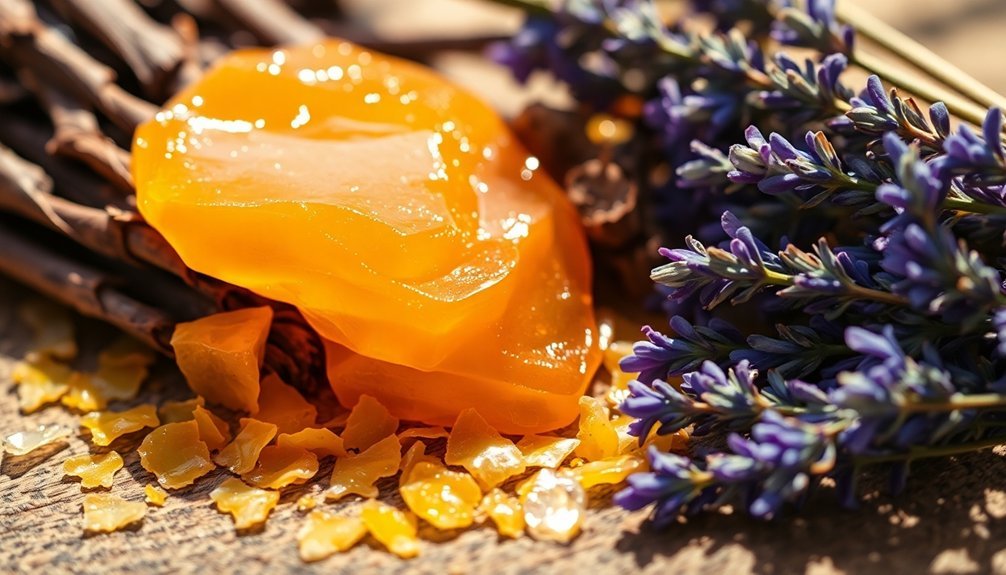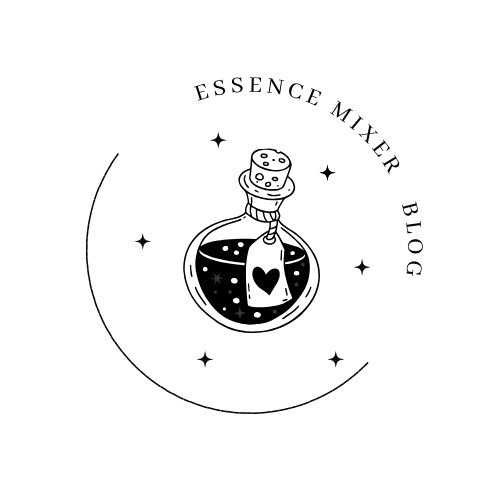To stabilize fragrant heart notes, you'll need to master temperature control and natural fixatives. Keep your blends at 60-70°F and use dark glass containers to protect from light exposure. Add natural fixatives like benzoin or myrrh to slow evaporation, and pair with compatible solvents like DPG for enhanced longevity. Create balanced ratios between 30-50% concentration, and layer your notes strategically. These professional techniques are just the beginning of achieving lasting aromatic excellence.
Essential Techniques for Middle Note Harmony

Every successful fragrance composition relies on masterful middle note harmony. To achieve this balance, you'll need to understand how complementary scent families work together in your fragrance.
Mastering middle notes is essential – they form the heart of your fragrance and create the seamless bridge between scent families.
Try pairing floral with fruity notes to create a well-rounded profile that captivates the senses.
When you're blending middle notes, focus on layering different essential oils strategically to build depth and character. You'll want to take into account each ingredient's volatility to guarantee your fragrance maintains stability and longevity throughout wear.
Pay special attention to how your middle notes interact with both top and base notes – this synergy is vital for a smooth shift from initial spritz to final dry down.
Balancing Heart Notes With Base and Top Notes
You'll discover that balancing heart notes with your base and top notes relies heavily on understanding frequency interactions and dynamic control.
To create depth in your mix, pay close attention to how your heart notes bridge the gap between crisp highs and rich lows, adjusting their intensity to maintain a natural flow.
The emotional impact of your mix depends on how skillfully you weave these elements together, ensuring each note complements rather than competes with the others.
Heart-Base Frequency Balance
When crafting a professional mix, achieving the right balance between heart notes and their surrounding frequencies can make or break your track's overall impact.
To master this balance, you'll need to focus on strategic frequency management between your heart notes (300 Hz – 3 kHz) and base notes (below 300 Hz).
Start by identifying and cutting overlapping frequencies in the 150-400 Hz range to prevent muddiness. You can use dynamic range compression to keep your heart notes stable and prominent without letting them get buried beneath the base notes.
Pay attention to your panning and volume adjustments – these tools help create essential space in your mix.
Remember to reference professional tracks as you work, using them as guides to guarantee you're maintaining the right relationship between your heart and base frequencies.
Depth Through Dynamic Control
Creating depth in your mix requires masterful control over the dynamic relationship between heart notes and their surrounding frequencies. You'll need to implement dynamic control to balance intensity levels while using EQ adjustments to carve out space for each element. Panning techniques further enhance separation, creating a three-dimensional soundscape.
| Technique | Purpose | Result |
|---|---|---|
| Compression | Controls dynamics | Balanced note presence |
| Transients | Shapes attack/release | Improved clarity |
| EQ | Manages frequencies | Enhanced separation |
| Panning | Creates space | Better dimensionality |
| Reference | Guides decisions | Professional polish |
Compare your mix against professional references to guarantee your dynamic choices serve the emotional impact of the composition. Focus on maintaining clarity between heart notes and supporting elements through careful adjustment of these essential mixing tools.
Emotional Mixing Techniques
Successful emotional mixing transcends technical proficiency by capturing the heart of a musical composition. When you're balancing heart notes with base and top notes, you'll need to understand how each element shapes the song's emotional landscape.
To achieve clarity in your mix, focus on dynamic automation and precise EQ adjustments that enhance the connection between the music and listener. You'll find that transient manipulation can bring heart notes forward while maintaining the integrity of surrounding elements.
Don't overprocess – subtle adjustments often yield the best results.
Remember that emotional mixing isn't just about technical decisions. It's about serving the song's narrative and artistic vision. By carefully considering how heart notes interact with other elements, you'll create mixes that resonate deeply with your audience while preserving the music's emotional core.
Temperature Control in Heart Note Preservation
The preservation of heart notes in fragrance mixing depends heavily on proper temperature control.
Temperature control is essential for preserving the delicate heart notes when blending fragrances, ensuring their integrity and longevity.
You'll need to maintain a consistent environment between 15-20°C (59-68°F) to protect your fragrance quality and prevent unwanted chemical changes. When you expose your mixes to excessive heat, volatile compounds evaporate, diminishing the heart notes' intensity.
To maximize the longevity of your heart notes, consider investing in a temperature-controlled storage system or fragrance vault.
These specialized solutions help you avoid the damaging effects of temperature fluctuations and prevent condensation that can dilute your carefully crafted scents.
Natural Fixatives for Lasting Middle Notes

While temperature control safeguards your fragrance composition, natural fixatives serve as the backbone for maintaining vibrant middle notes.
You'll find traditional options like benzoin, myrrh, and labdanum particularly effective at slowing down the evaporation of volatile components, ensuring your scent lingers longer on the skin.
To enhance your blend's complexity, incorporate essential oils such as sandalwood and vetiver.
These not only act as natural fixatives but also contribute their distinct aromatic signatures to your creation.
When you're crafting artisanal perfumes, these natural stabilizers deliver an authentic, earthy character that synthetic alternatives can't match.
They'll help you achieve a more rounded scent profile by anchoring those elusive middle notes while adding depth and richness to your overall fragrance composition.
Layering Methods for Enhanced Stability
You'll achieve a more stable mix by carefully balancing multiple layers of complementary sounds across the frequency spectrum.
Creating depth through strategic EQ and compression helps each layer find its own sonic space while maintaining cohesion with neighboring elements.
When you're working with multiple heart layers, focus on dynamic control and frequency separation to prevent masking while preserving the natural character of each sound.
Balance Multiple Heart Layers
Successfully balancing multiple heart layers requires a strategic approach to frequency management and spatial distribution. You'll need to carefully analyze each layer's frequency content and use EQ to carve out specific ranges, preventing overlap that could mask important elements.
When working with multiple layers, you'll want to apply compression and transient shaping to control dynamics effectively. This helps maintain balance while ensuring each layer sits perfectly in the mix.
Consider using panning techniques to create width and depth, but keep your stereo image coherent and supportive.
Don't forget to reference professional tracks regularly as you adjust your layers. This practice will help you make informed decisions about frequency allocation and spatial placement, ultimately leading to a more stable and harmonious blend of heart layers.
EQ Compression For Depth
Creating depth in layered sounds demands precise control over both EQ and compression techniques.
You'll want to focus on cutting unnecessary frequencies between 150-400 Hz to prevent masking and enhance clarity in your mix. This targeted EQ approach lets each layer breathe and occupy its own space.
When applying compression, you're aiming to stabilize the dynamic range while maintaining the natural punch of your sounds.
Use transient shapers to fine-tune the attack and release, allowing you to sculpt how each layer sits in the mix.
Remember to regularly compare your work against reference tracks to guarantee you're achieving professional-grade depth.
Solvent Selection and Heart Note Performance

While heart notes form the core of any fragrance composition, their performance largely depends on selecting the right solvents. You'll find that proper solvent selection affects how your heart notes dissolve, diffuse, and maintain their intended scent profile. When you're working with fragrance materials, consider using ethanol or dipropylene glycol for ideal results.
| Solvent Type | Evaporation Rate | Heart Note Impact |
|---|---|---|
| Ethanol | Fast | Sharp projection |
| DPG | Slow | Extended longevity |
| Benzyl Benzoate | Very slow | Deep fixation |
| IPM | Medium | Balanced diffusion |
| DEP | Slow-medium | Enhanced stability |
Your solvent choice will influence how your heart notes interact with air and light, potentially modifying their olfactory characteristics. Remember that slower-evaporating solvents can greatly extend the wear time of your fragrance while maintaining its intended scent profile.
Blending Ratios for Optimal Heart Note Expression
The art of balancing heart notes demands precise ratios, typically ranging from 30% to 50% of your total fragrance composition.
You'll want to carefully blend floral and fruity elements with spicier or woodier notes to create a well-rounded profile that captivates the senses.
When working with blending ratios, you can experiment by adjusting the concentration of certain floral notes to invigorate your fragrance's middle section.
Don't forget to incorporate fixatives to stabilize volatile components, ensuring your heart notes maintain their character throughout wear.
Test your blends consistently, as even minor tweaks can dramatically impact the overall scent experience.
You'll find that taking time to evaluate different ratios helps you achieve the perfect balance between longevity and diffusion in your fragrance composition.
Storage Strategies for Middle Note Longevity
Proper storage plays a pivotal role in preserving your middle notes' aromatic integrity and lasting power. You'll need to protect your fragrances from common environmental factors that can diminish their quality.
| Storage Factor | Impact on Longevity |
|---|---|
| Temperature | Keep at 60-70°F |
| Light Exposure | Use dark bottles |
| Location | Cool, dry spaces |
| Rotation | Use older first |
To maintain your fragrances' integrity, store them in tightly sealed dark glass containers away from bathrooms and windows. Don't let heat, humidity, or direct sunlight compromise your precious scents. You'll want to establish a rotation system to guarantee older fragrances get used before they deteriorate. By following these storage strategies, you'll extend the longevity of your middle notes and protect your fragrance investment.
Choosing Compatible Heart Note Combinations
Beyond storing your fragrances correctly, selecting compatible heart notes becomes your next creative challenge. The key to creating harmonious combinations lies in understanding how different scents interact. You'll find inner peace when you pair floral notes like jasmine with fruity elements, creating an inviting blend that'll help us achieve a balanced profile.
Consider combining spicy heart notes with warm base notes to add complexity to your fragrance. Cinnamon and cardamom work beautifully with vanilla or amber undertones.
For a revitalizing twist, try incorporating herbal notes like lavender or basil alongside sweeter components. The magic happens when you experiment with light and heavy heart notes together, allowing your fragrance to evolve naturally throughout the day.
Dilution Techniques for Heart Note Clarity
When working with heart notes, mastering dilution techniques becomes essential for achieving crystal-clear aromatic profiles.
You'll find that using carrier substances like alcohol or oil helps you create balanced blends that won't overpower your fragrance every time. Testing different dilution ratios at different times guarantees ideal results for your unique scent combinations.
- Start with dilution ratios between 10% and 30% to maintain the fragrance's integrity while enhancing clarity
- Use gradual blending techniques to test small batches before scaling up
- Apply carrier substances consistently to achieve smoother aromatic experiences
- Monitor how your diluted heart notes evolve over time to guarantee proper longevity
Timing the Addition of Middle Notes
Building on the precision of dilution techniques, the art of timing middle note additions can transform your mix from good to exceptional.
You'll want to carefully assess your mix's dynamics before introducing these vital elements that bridge your high and low frequencies.
Don't rush to add middle notes too early – this can create unwanted clutter. Instead, wait for the right moment when your mix needs that extra warmth and depth.
You'll find that gradual automation can help you achieve a more natural integration, letting the middle notes weave seamlessly into your existing elements.
As you experiment with different timing approaches, pay attention to how middle notes affect the spatial qualities and texture of your mix.
They should enhance the harmonic richness while maintaining the emotional progression of your composition.
Frequently Asked Questions
How Do Seasonal Changes Affect the Stability of Heart Notes?
Temperature fluctuations in different seasons can impact your heart notes' stability. You'll notice they evaporate faster in summer heat and last longer in winter cold, affecting their overall performance and longevity.
Can Digital Analysis Tools Help Predict Heart Note Deterioration Patterns?
You'll find digital tools like spectrometers and chromatography software can track heart note degradation patterns. They'll help you predict shelf life and identify potential stability issues before they become problematic in your formulations.
What Role Do Antioxidants Play in Preserving Heart Note Integrity?
You'll find antioxidants protect heart notes by preventing oxidation and molecular breakdown. They'll shield delicate aromatic compounds from degrading, helping maintain the fragrance's integrity and extending its longevity in your blend.
How Does Altitude Impact the Performance of Heart Note Compounds?
You'll notice heart notes evaporate faster at higher altitudes due to lower air pressure. They'll become more volatile and diffuse quickly, so you'll need to increase their concentration to maintain desired performance.
Do Electromagnetic Fields Affect the Molecular Structure of Heart Notes?
You'll find that electromagnetic fields don't greatly affect heart note molecules. While some compounds may experience minor electronic excitation, there's no evidence of structural changes that would impact fragrance performance or stability.
In Summary
You've now mastered the essential techniques for stabilizing those elusive heart notes in your fragrance compositions. By implementing proper temperature control, natural fixatives, and strategic layering, you'll create longer-lasting middle notes that sing in harmony with your base and top notes. Remember, timing and dilution are critical – they're the keys to achieving that perfect balance you're after in your signature scents.





Leave a Reply